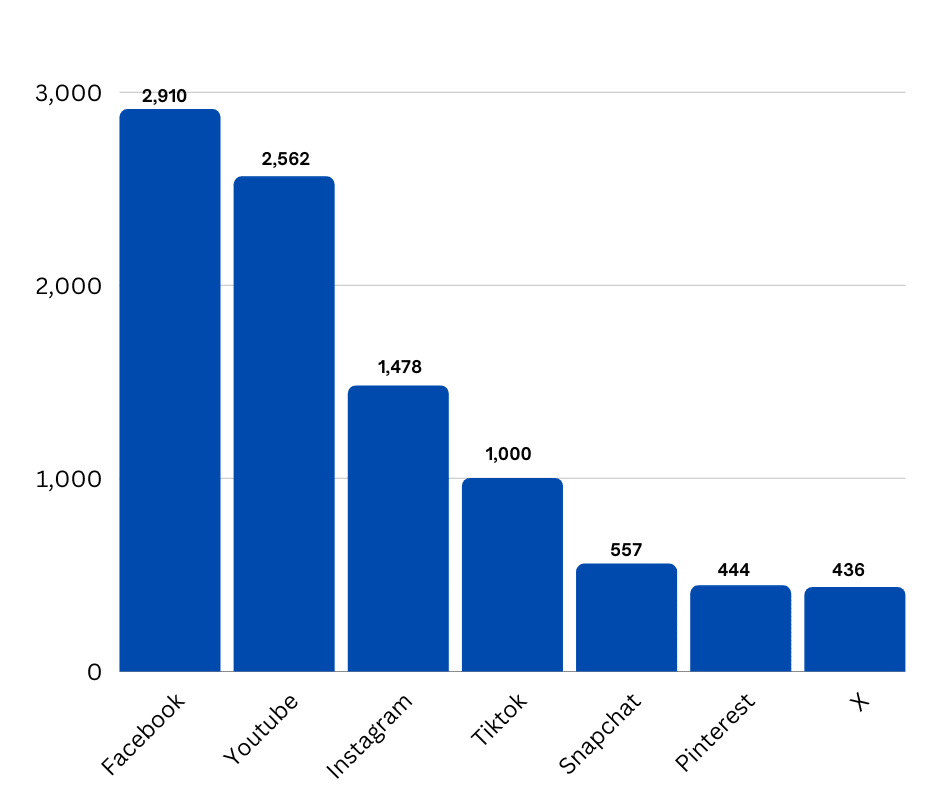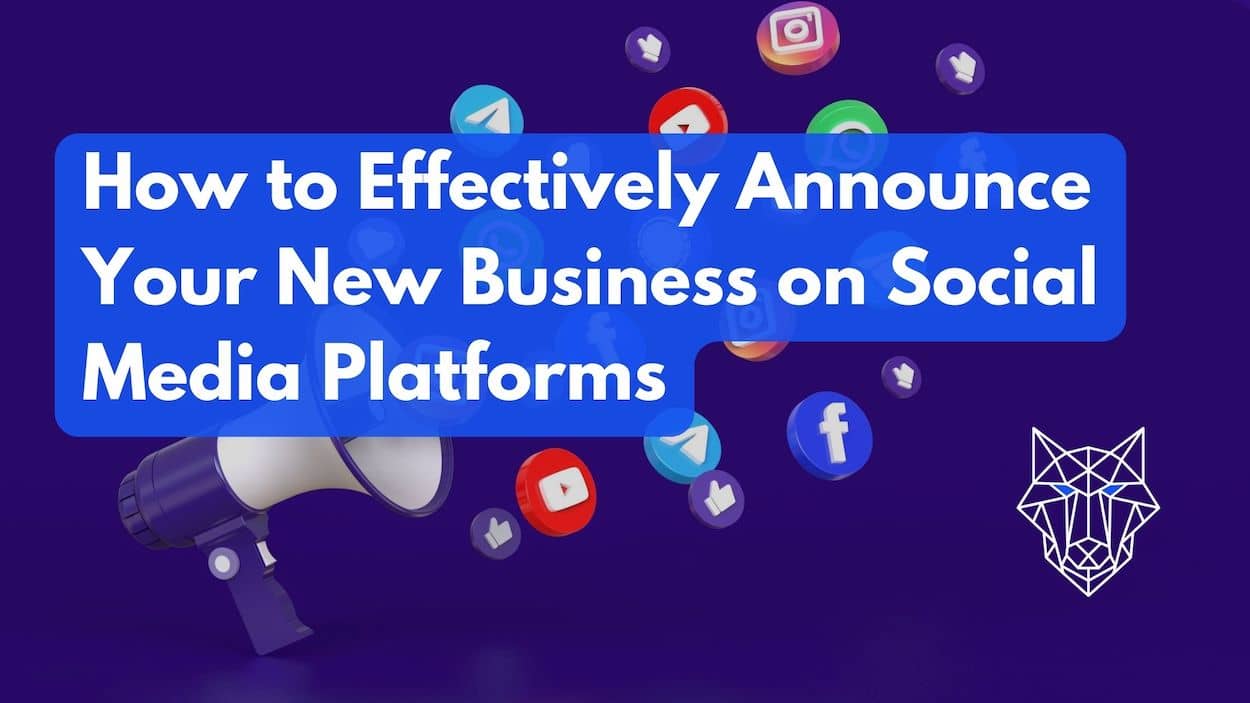Launching a new business is an exciting endeavor that requires careful planning and strategic execution, and understanding how to announce a new business on social media is one of the most effective ways to create buzz, generate interest in your new venture, and ensure a successful start. In fact, according to recent statistics, 90% of marketers agree that social media is crucial for their business success.
In this guide, we will outline the key steps to successfully announce your new business on various social media platforms.
Define Your Target Audience

In the process of bringing a product or service to the market, certain essential steps must be taken into consideration. This includes conducting thorough research, dedicating time, and exercising patience. One of the pivotal aspects before launching is to clearly define your target audience. Understanding your audience is the linchpin for effective planning of your content, choosing the appropriate social media platforms, and executing successful advertising campaigns when announcing your new business on social media.
To effectively define your target audience, it’s crucial to follow a strategic approach.
Here are the steps to assist you in this process:
Research: Initiate by conducting comprehensive market research to gather essential insights about your potential customers. Additionally, dive into data regarding demographics, including age, gender, location, and income level. Furthermore, delve into their interests, preferences, and behaviors that are relevant to your industry or niche.
Create Buyer Personas: Develop detailed buyer personas, which represent fictional characters embodying the characteristics of your target audience segments.
Identify Pain Points: Recognize the specific problems or challenges that your target audience encounters and that your business can address effectively. In addition, tailor your messaging to directly tackle these needs, positioning your business as a reliable solution provider.
Segmentation: Divide your target audience into smaller, more manageable segments based on shared characteristics or behaviors. For instance, different approaches may be required for segments such as young professionals and retirees.
Social Listening: Engage in social listening by monitoring social media platforms and online communities where your target audience actively participates. Moreover, pay close attention to their conversations, comments, and feedback. Additionally, these insights into their preferences, opinions, and pain points can be invaluable for shaping your content creation and engagement strategies.
Choose the Right Social Media Platforms

When it comes to announcing a new business on social media, each platform has its own set of pros and cons. Social media marketing uses platforms like Facebook, Twitter, and Instagram to promote products, engage with customers, drive website traffic, and reach new customers.
Here are some factors to consider for each platform, along with tips to make the most of your announcements:
Facebook:
- Pros: Wide reach, ability to target specific demographics through ads, opportunity for engagement through comments and shares.
- Cons: Organic reach can be limited, and algorithm changes may affect visibility.
- Unique features: Facebook Groups allow you to create communities around your brand, fostering deeper connections with your audience.
- Tips: Use eye-catching visuals, craft compelling captions, and encourage followers to share your announcement to increase reach.
Before structuring your Facebook profile, it is important to ensure your Business page is set up correctly. Facebook profiles are a way to connect with others and share updates, photos, and videos. To get started, create an account on the Facebook website. Creating and managing a Facebook profile is a simple process that allows you to connect with others and share your experiences.
YouTube:
- Pros: Video content can be highly engaging, potential for long-term visibility through search.
- Cons: Requires resources for video production, and competition from other creators.
- Unique features: YouTube Live allows you to host live events and interact with your audience in real-time.
- Tips: Create high-quality videos that showcase your brand, optimize titles and descriptions for search, and collaborate with popular YouTubers or influencers to reach their audience.
Instagram:
- Pros: Visual appeal, high engagement rates, use of hashtags to increase discoverability.
- Cons: Limited link placement (in bio or swipe-up feature for accounts with 10k+ followers), competition for attention in a visually-driven platform.
- Unique features: Instagram Stories provide an ephemeral and interactive way to announce your business.
- Tips: Create aesthetically pleasing posts, leverage user-generated content, and collaborate with influencers or micro-influencers to expand your reach.
Tiktok
- Pros: Easy to use, creative platform, has viral potential, and has a large global community.
- Cons: Raises privacy concerns, can be time-consuming, and has content that may not be suitable for all audiences.
- Unique features: It allows users to create duets with others, has a vast library of sound and music clips, and is known for viral challenges and clips.
- Tips: Be consistent with posting to increase chances of going viral, engage with the community, experiment with different content, and use trending hashtags to reach a wider audience.
Snapchat:
- Pros: Younger demographic, authentic and ephemeral content.
- Cons: Limited analytics, short lifespan of snaps.
- Unique features: Geofilters and lenses allow for creative branding opportunities.
- Tips: Create engaging and interactive snaps, leverage influencers or brand ambassadors, and use geofilters to promote your business at specific locations or events.
Pinterest:
- Pros: Visual platform, predominantly female user base, the potential for driving traffic to your website.
- Cons: Limited organic reach, may not be suitable for all business types.
- Unique features: Rich Pins provide additional information about your products or services.
- Tips: Create visually appealing pins, utilize keywords and hashtags, and join group boards to increase exposure.
X (formally Twitter):
- Pros: Real-time updates, potential for viral reach through retweets and trending topics.
- Cons: Character limit can restrict message length, fast-paced nature may require frequent posting.
- Unique features: Effective use of hashtags can amplify your announcement’s visibility.
- Tips: Craft concise and attention-grabbing tweets. Moreover, engage with your audience through replies and retweets, and actively participate in relevant conversations to increase exposure.
Incorporate SEO into Your Social Media Posts
When announcing your new business on social media platforms, incorporating SEO (Search Engine Optimization) into your posts can significantly enhance your visibility and reach.
Here are some tips to effectively utilize SEO in your social media announcements:
Keyword Research: Conduct keyword research to identify relevant terms and phrases that your target audience is likely to search for. Furthermore, use tools like Google Keyword Planner or SEMrush to find popular keywords related to your industry or niche.
Optimize Your Profiles: Ensure that your social media profiles are fully optimized with relevant keywords. Furthermore, include your business name, a concise and keyword-rich description, and a link to your website. This will help search engines understand the nature of your business and improve your chances of appearing in relevant search results.
Craft Engaging Headlines: Create attention-grabbing headlines for your social media posts that incorporate relevant keywords.
Use Keywords in Captions and Descriptions: Incorporate your target keywords naturally into the captions and descriptions of your social media posts. In addition, this will make your content more searchable and increase its visibility in search engine results.
Hashtag Strategy: Utilize relevant hashtags in your social media posts to increase discoverability. Moreover, research popular hashtags within your industry and include them strategically in your posts. This will help your content reach a wider audience.
Link Building: Include links to your website or specific landing pages in your social media posts. This will not only drive traffic to your site but also improve your website’s search engine rankings.
Consistency and Frequency: Regularly post high-quality content on your social media platforms. Additionally, search engines favor active and consistent profiles. By maintaining a regular posting schedule, you increase the chances of your content being indexed and ranked by search engines.
Engage with Your Audience: Actively engage with your audience by responding to comments, messages, and mentions. This not only helps build relationships but also signals to search engines that your social media profiles are active and relevant.
Pro-tip: In addition to social media analytics, it’s important to track and optimize your business’s SEO (Search Engine Optimization) to improve your online visibility. WolfPack Advising can provide expertise in this area to help you effectively track and optimize your SEO efforts. Remember that SEO is an ongoing process, and results may take time to materialize.
What’s the pricing structure for hiring a marketing agency? Marketing agencies typically offer main pricing structures.
Run Targeted Ads with PPC Advertising
To amplify your reach and target specific segments of your audience, consider running Pay-Per-Click (PPC) advertising campaigns. Platforms like Google Ads and Facebook Ads offer robust targeting options that allow you to reach potential customers who are most likely to be interested in your business. In fact, businesses that use PPC advertising generate an average of $2 in revenue for every $1 spent.
Here are some tips to make the most of your PPC campaigns:
Choose the Right Platform: Select social media platforms that align with your audience and objectives. Additionally, options like Facebook, Instagram, Twitter, and LinkedIn offer distinct advantages and user bases.
Create Compelling Ad Copy: Craft engaging and persuasive ad text that emphasizes your unique selling points. Moreover, clearly conveys value and prompt action.
Design Eye-Catching Visuals: Utilize high-quality visuals that capture attention and reflect your brand identity. Furthermore, ensure images or videos align with your message.
Optimize Landing Pages: Make sure landing pages linked from your ads are conversion-optimized and consistent with ad messaging. Additionally, this will ensure a seamless user experience.
Monitor and Optimize: Regularly track ad performance and apply data-driven enhancements. Test different ad variants, targeting options, and bidding strategies for continuous improvement.
Budget Management: Set a realistic budget and strategically allocate it across campaigns. Additionally, keep a close eye on spending and make necessary adjustments to bids in order to maximize ROI.
Integrate Marketing Automation

Marketing automation tools help streamline your social media efforts by automating repetitive tasks such as scheduling posts, monitoring mentions, and analyzing performance. Research has shown that businesses that use marketing automation experience a 451% increase in qualified leads.
Here are some tips to effectively integrate marketing automation into your strategy:
Segment Your Audience: Divide your target audience into segments based on demographics, interests, behaviors, or engagement levels. Furthermore, this allows you to create personalized and targeted campaigns that resonate with each segment.
Create Engaging Content: Develop a content strategy that includes a mix of informative, entertaining, and promotional content. Additionally, use marketing automation to schedule and publish your posts across multiple social media platforms at optimal times.
Automate Social Media Posting: Utilize marketing automation tools to schedule and automate your social media posts in advance. This ensures consistent and timely content delivery.
Lead Nurturing: Implement automated lead nurturing workflows to guide potential customers through the buyer’s journey. Moreover, use social media interactions as triggers to deliver targeted content and offers that move prospects closer to conversion.
Track and Analyze: Leverage the analytics capabilities of your marketing automation platform to measure the performance of your social media campaigns. Monitor key metrics such as reach, engagement, click-through rates, and conversions to identify areas for improvement.
Integrate with CRM: Integrate your marketing automation platform with a customer relationship management (CRM) system to ensure seamless data flow between marketing and sales teams. Additionally, this enables better lead tracking, follow-ups, and personalized communication.
Choose the Right Automation Tools: Research and select a marketing automation platform that aligns with your business needs. Moreover, ensure it integrates well with your chosen social media platforms.
Pro-tip: One company that specializes in managing CRM for different home inspection companies all over the country is WolfPack Advising. As a digital marketing company, they offer comprehensive solutions to help businesses optimize their customer relationship management processes.
By leveraging their expertise, you can enhance your social media strategy and effectively announce your new business.
Invest in Reliable Web Hosting for a Faster-Loading Website
A fast-loading website is essential for providing a seamless user experience. Invest in reliable web hosting services to ensure your website loads quickly and efficiently. A slow website can deter potential customers, resulting in missed opportunities. In fact, studies have found that 40% of users will abandon a website if it takes more than 3 seconds to load.
Here are some tips to help you make the most of your web hosting:
Choose a Reliable Web Hosting Provider: Research and select a reputable web hosting provider that offers reliable services, excellent uptime, and fast server response times. Furthermore, look for providers with positive customer reviews and a track record of delivering high-quality hosting solutions.
Consider Your Website’s Requirements: Assess your website’s needs in terms of storage space, bandwidth, and scalability. Additionally, choose a web hosting plan that can accommodate your current requirements and allow room for future growth as your business expands.
Optimize Website Performance: Optimize your website’s performance by implementing techniques such as caching, compression, and image optimization. These measures can significantly improve loading times and enhance the user experience.
Utilize Content Delivery Networks (CDNs): CDNs distribute your website’s content across multiple servers worldwide, reducing latency and improving loading speeds for users in different geographic locations. Moreover, consider integrating a CDN into your web hosting setup for optimal performance.
Regularly Update Software and Plugins: Keep your website’s software, CMS (Content Management System), and plugins up to date. Additionally, regular updates often include performance improvements and security patches that can enhance your website’s speed and reliability.
Monitor Website Speed: Utilize tools like Google PageSpeed Insights or GTmetrix to regularly monitor your website’s loading speed. Identify areas for improvement and take the necessary steps to optimize your website accordingly.
Implement Caching: Enable browser caching and server-side caching to store static versions of your website’s pages. This allows returning visitors to load your site more quickly by retrieving cached content instead of generating it from scratch.
Regular Backups: Choose a web hosting provider that offers regular backups of your website’s data. In the event of any issues or data loss, having reliable backups ensures you can quickly restore your website to its previous state. Additionally, initiate by conducting comprehensive market research to gather essential insights about your potential customers.
Pro-tip: Investing in reliable web hosting is essential for ensuring a fast-loading website, which is crucial for providing a positive user experience and maximizing your online presence. Wolfpack Advising understands the importance of reliable web hosting and can assist you in making the right choices for your new business. By following their expert advice and implementing the tips mentioned above, you can effectively announce your new business on social media platforms and ensure that visitors to your website have a seamless and enjoyable browsing experience.
Track Results

Social media analytics, including insights on how to announce a new business on social media, refers to the data and insights gathered from social media platforms that help you understand the performance of your campaigns. By regularly monitoring and analyzing these metrics, you can gain valuable insights into what is working well and what needs improvement. Platforms like Facebook, Pinterest, Twitter, and TikTok provide built-in analytics tools that show metrics such as engagement rates, reach, impressions, and follower growth. Additionally, implementing tracking pixels on your website, such as a Facebook pixel, allows you to track specific actions taken by users who clicked on your ads, providing deeper insights into the effectiveness of your advertising campaigns and measuring conversions.
When it comes to Instagram, understanding its algorithm is crucial for success. The Instagram algorithm determines the order in which posts appear on users’ feeds based on various factors. These factors include the user’s past interactions, the timeliness of the post, and the user’s interests.
By utilizing social media analytics and tracking pixels, you can gather data-driven insights about your audience’s preferences, behaviors, and the success of your marketing efforts. Additionally, this information helps you make informed decisions, refine your content strategy, target your ads effectively, and optimize your campaigns for better results. Regularly tracking your social media metrics increases your chances of achieving your marketing goals and improving your overall social media presence.
Social Media Competitor Analysis and Its Importance
Social media has emerged as a powerful tool for businesses to connect with their target audience and promote their products or services. However, in a highly competitive marketplace, it is crucial for companies to stay ahead of the curve and gain a competitive edge.
One effective way to achieve this is through social media competitor analysis. This process involves studying and analyzing the online presence, strategies, and activities of your competitors on various social media platforms. Additionally, by examining and evaluating the competitors’ online presence, strategies, and activities on social media platforms, companies can:
Identify industry trends: Gain insights into what works and what doesn’t by monitoring competitors’ content, hashtags, and engagement rates.
Benchmark against best practices: Set benchmarks and improve tactics by learning from successful competitors.
Discover untapped opportunities: Tailor strategies to capitalize on gaps or areas where competitors are not focusing.
Stay updated on new features and platforms: Adapt quickly by monitoring competitors’ adoption of new social media features.
Mitigate risks and learn from mistakes: Learn from how competitors handle challenges to develop strategies for your own business.
Social media competitor analysis is an essential component of any successful social media strategy. By comprehending your competitors’ activities, strengths, and weaknesses, you can gain a strategic advantage. Furthermore, this advantage, in turn, enables you to differentiate yourself from the competition and achieve long-term success in the ever-evolving social media landscape.
Work with a Social Media Expert for Optimal Results
Partnering with a social media expert, such as Wolfpack Advising, is crucial for effectively announcing your new business on social media platforms.
Statistics show that businesses working with social media experts experience increased engagement rates, improved reach, higher conversion rates, and better return on investment. Moreover, these experts possess knowledge of each platform’s algorithm and best practices. This expertise allows them to create engaging content and develop effective strategies on how to announce a new business on social media, ensuring it reaches the right audience.
Moreover, by collaborating with a social media expert and implementing Wolfpack’s growth roadmap, you can maximize your chances of success and ensure that your new business gains visibility and traction on social media. Wolfpack’s growth roadmap emphasizes a collaborative and unified approach to achieving business growth, aligning seamlessly with the expertise of social media professionals to propel your brand toward unprecedented success.
Conclusion
Effectively announcing ‘how to announce a new business on social media’ requires careful planning, targeted outreach, and strategic execution. By following the steps outlined in this guide and maintaining a professional tone throughout your communications, you can successfully generate excitement, attract potential customers, and propel your new business toward success. Remember, social media is a powerful tool that, when used correctly, can significantly impact the growth and success of your business.




